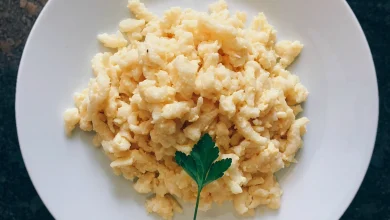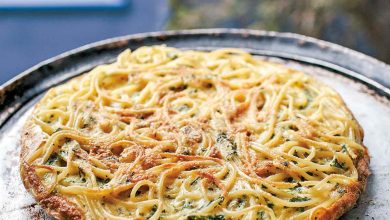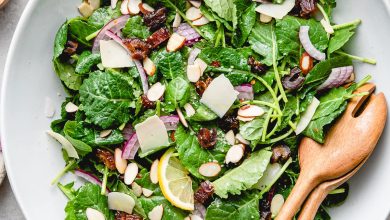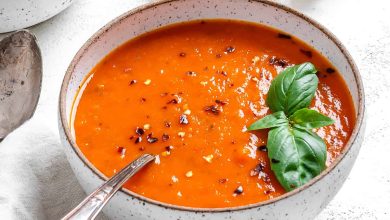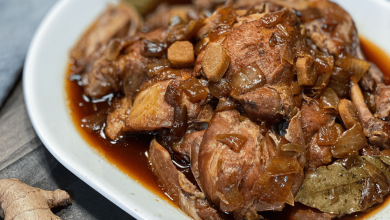👌 Awesome! Olive Bruschetta is a delicious and flavorful Italian appetizer that combines the rich and briny flavors of olives with the crunch of toasted bread. Let’s dive into its history, components, preparation steps, and time needed to make it. 🍞🫒
What is Olive Bruschetta?
Olive Bruschetta is a traditional Italian antipasto, often served as an appetizer. It’s made by topping toasted bread slices with a mixture of chopped olives, tomatoes, fresh herbs, garlic, and olive oil. The word “bruschetta” itself refers to the toasted bread, typically rubbed with garlic and drizzled with olive oil.
History:
The origin of bruschetta can be traced back to ancient Rome, where it was a simple way of using up stale bread. It gained popularity in Italy and has since become a beloved dish worldwide. Olive Bruschetta, a variation of the classic bruschetta, likely emerged as people experimented with different toppings.
Components:
- Bread: Usually a rustic Italian bread like ciabatta or baguette, sliced and toasted.
- Olives: Kalamata, green, or black olives, pitted and chopped.
- Tomatoes: Fresh, ripe tomatoes, diced.
- Fresh Herbs: Typically basil or parsley, finely chopped.
- Garlic: Fresh garlic cloves, minced or used to rub the toasted bread.
- Olive Oil: High-quality extra virgin olive oil for drizzling and flavor.
- Salt and Pepper: To season the topping.
Steps to Prepare Olive Bruschetta:
-
Prepare the Ingredients: Gather all your components – olives, tomatoes, fresh herbs, garlic, and olive oil. Slice and toast the bread until it’s golden brown.
-
Make the Olive Mixture: In a bowl, combine the chopped olives, diced tomatoes, minced garlic, chopped herbs, and a generous drizzle of olive oil. Season with salt and pepper to taste.
-
Assemble: Take your toasted bread slices and, if desired, rub them with a garlic clove for an extra layer of flavor. Spoon the olive mixture generously onto each slice.
-
Serve: Arrange the prepared bruschettas on a platter and serve immediately. You can also garnish with extra herbs or a drizzle of olive oil.
Time Needed:
The time required to prepare Olive Bruschetta depends on your efficiency in chopping and toasting. On average, it can take about 15-20 minutes. This makes it a perfect quick and tasty option for a last-minute appetizer when you have guests over.
Now you have the recipe, history, and components of Olive Bruschetta at your fingertips. Enjoy making and savoring this delightful Italian treat! 🇮🇹🫒🍅🍞
Certainly! Here are the nutrition facts and some health information for Olive Bruschetta:
Nutrition Facts (per serving, approximately 2 slices of bruschetta):
- Calories: Approximately 180-200 calories
- Fat: About 10-12 grams
- Saturated Fat: 1-2 grams
- Carbohydrates: Around 20-25 grams
- Dietary Fiber: 2-3 grams
- Sugars: 1-2 grams
- Protein: 4-6 grams
- Sodium: 350-450 milligrams (varies based on the amount of salt and olives used)
Health Information:
-
Good Source of Healthy Fats: Olive oil, a key ingredient in Olive Bruschetta, is rich in monounsaturated fats, which are considered heart-healthy and may help reduce the risk of heart disease.
-
Fiber: The combination of bread and vegetables in Olive Bruschetta provides some dietary fiber, aiding in digestion and promoting a feeling of fullness.
-
Vitamins and Minerals: The tomatoes in the topping provide vitamins like C and K, while the herbs add additional nutrients. Olives are a source of healthy fats and contain some vitamins and minerals as well.
-
Moderation: While Olive Bruschetta can be a tasty and relatively healthy appetizer, it’s essential to enjoy it in moderation. The bread provides carbohydrates, and the olives and olive oil contribute calories from fats. Be mindful of portion sizes, especially if you’re watching your calorie intake.
-
Sodium: The sodium content can vary, mainly based on the type and amount of olives used. If you’re on a low-sodium diet, consider using olives with reduced salt content.
-
Customization: You can make Olive Bruschetta even healthier by choosing whole-grain bread for added fiber or using a light hand with olive oil for reduced fat content.
Remember that the specific nutrition values may vary based on the exact ingredients and proportions you use. Always consult with a healthcare professional or nutritionist for personalized dietary advice and information.



